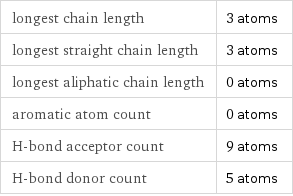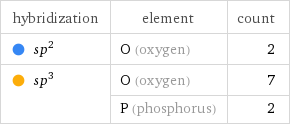Input interpretation

calcium dihydrogen phosphate monohydrate
Basic properties
![molar mass | 252.1 g/mol formula | CaH_6O_9P_2 empirical formula | O_9P_2Ca_H_6 SMILES identifier | [Ca+2].OP(=O)(O)[O-].OP(=O)(O)[O-].O InChI identifier | InChI=1/Ca.2H3O4P.H2O/c;2*1-5(2, 3)4;/h;2*(H3, 1, 2, 3, 4);1H2/q+2;;;/p-2/fCa.2H2O4P.H2O/h;2*1-2H;/qm;2*-1; InChI key | ZBZJARSYCHAEND-UHFFFAOYSA-L](../image_source/6c963d91936cd6d42439c7959ea08479.png)
molar mass | 252.1 g/mol formula | CaH_6O_9P_2 empirical formula | O_9P_2Ca_H_6 SMILES identifier | [Ca+2].OP(=O)(O)[O-].OP(=O)(O)[O-].O InChI identifier | InChI=1/Ca.2H3O4P.H2O/c;2*1-5(2, 3)4;/h;2*(H3, 1, 2, 3, 4);1H2/q+2;;;/p-2/fCa.2H2O4P.H2O/h;2*1-2H;/qm;2*-1; InChI key | ZBZJARSYCHAEND-UHFFFAOYSA-L
Structure diagram

Structure diagram
Quantitative molecular descriptors

longest chain length | 3 atoms longest straight chain length | 3 atoms longest aliphatic chain length | 0 atoms aromatic atom count | 0 atoms H-bond acceptor count | 9 atoms H-bond donor count | 5 atoms
Elemental composition
![Find the elemental composition for SMILES:O.P(=O)(O)(O)[O-].[Ca+2].P(=O)(O)(O)[O-] in terms of the atom and mass percents: atom percent = N_i/N_total × 100% mass percent = (N_im_i)/m × 100% Plan: • Write the chemical formula and gather atomic masses from the periodic table. • Determine values for N_i, m_i, N_total and m using these items. • Finally, compute the percents and check the results. Write the chemical formula: CaH_6O_9P_2 Use the chemical formula to count the number of atoms, N_i, for each element and find the total number of atoms, N_total: | number of atoms O (oxygen) | 9 P (phosphorus) | 2 Ca (calcium) | 1 H (hydrogen) | 6 N_total = 9 + 2 + 1 + 6 = 18 Divide each N_i by N_total to calculate atom fractions. Then use the property that atom fractions must sum to one to check the work: | number of atoms | atom fraction O (oxygen) | 9 | 9/18 P (phosphorus) | 2 | 2/18 Ca (calcium) | 1 | 1/18 H (hydrogen) | 6 | 6/18 Check: 9/18 + 2/18 + 1/18 + 6/18 = 1 Compute atom percents using the atom fractions: | number of atoms | atom percent O (oxygen) | 9 | 9/18 × 100% = 50.0% P (phosphorus) | 2 | 2/18 × 100% = 11.1% Ca (calcium) | 1 | 1/18 × 100% = 5.56% H (hydrogen) | 6 | 6/18 × 100% = 33.3% Look up the atomic mass, m_i, in unified atomic mass units, u, for each element in the periodic table: | number of atoms | atom percent | atomic mass/u O (oxygen) | 9 | 50.0% | 15.999 P (phosphorus) | 2 | 11.1% | 30.973761998 Ca (calcium) | 1 | 5.56% | 40.078 H (hydrogen) | 6 | 33.3% | 1.008 Multiply N_i by m_i to compute the mass for each element. Then sum those values to compute the molecular mass, m: | number of atoms | atom percent | atomic mass/u | mass/u O (oxygen) | 9 | 50.0% | 15.999 | 9 × 15.999 = 143.991 P (phosphorus) | 2 | 11.1% | 30.973761998 | 2 × 30.973761998 = 61.947523996 Ca (calcium) | 1 | 5.56% | 40.078 | 1 × 40.078 = 40.078 H (hydrogen) | 6 | 33.3% | 1.008 | 6 × 1.008 = 6.048 m = 143.991 u + 61.947523996 u + 40.078 u + 6.048 u = 252.064523996 u Divide the mass for each element by m to calculate mass fractions. Then use the property that mass fractions must sum to one to check the work: | number of atoms | atom percent | mass fraction O (oxygen) | 9 | 50.0% | 143.991/252.064523996 P (phosphorus) | 2 | 11.1% | 61.947523996/252.064523996 Ca (calcium) | 1 | 5.56% | 40.078/252.064523996 H (hydrogen) | 6 | 33.3% | 6.048/252.064523996 Check: 143.991/252.064523996 + 61.947523996/252.064523996 + 40.078/252.064523996 + 6.048/252.064523996 = 1 Compute mass percents using the mass fractions: Answer: | | | number of atoms | atom percent | mass percent O (oxygen) | 9 | 50.0% | 143.991/252.064523996 × 100% = 57.12% P (phosphorus) | 2 | 11.1% | 61.947523996/252.064523996 × 100% = 24.58% Ca (calcium) | 1 | 5.56% | 40.078/252.064523996 × 100% = 15.90% H (hydrogen) | 6 | 33.3% | 6.048/252.064523996 × 100% = 2.399%](../image_source/c7f604e61a4ce591ad516929f2598116.png)
Find the elemental composition for SMILES:O.P(=O)(O)(O)[O-].[Ca+2].P(=O)(O)(O)[O-] in terms of the atom and mass percents: atom percent = N_i/N_total × 100% mass percent = (N_im_i)/m × 100% Plan: • Write the chemical formula and gather atomic masses from the periodic table. • Determine values for N_i, m_i, N_total and m using these items. • Finally, compute the percents and check the results. Write the chemical formula: CaH_6O_9P_2 Use the chemical formula to count the number of atoms, N_i, for each element and find the total number of atoms, N_total: | number of atoms O (oxygen) | 9 P (phosphorus) | 2 Ca (calcium) | 1 H (hydrogen) | 6 N_total = 9 + 2 + 1 + 6 = 18 Divide each N_i by N_total to calculate atom fractions. Then use the property that atom fractions must sum to one to check the work: | number of atoms | atom fraction O (oxygen) | 9 | 9/18 P (phosphorus) | 2 | 2/18 Ca (calcium) | 1 | 1/18 H (hydrogen) | 6 | 6/18 Check: 9/18 + 2/18 + 1/18 + 6/18 = 1 Compute atom percents using the atom fractions: | number of atoms | atom percent O (oxygen) | 9 | 9/18 × 100% = 50.0% P (phosphorus) | 2 | 2/18 × 100% = 11.1% Ca (calcium) | 1 | 1/18 × 100% = 5.56% H (hydrogen) | 6 | 6/18 × 100% = 33.3% Look up the atomic mass, m_i, in unified atomic mass units, u, for each element in the periodic table: | number of atoms | atom percent | atomic mass/u O (oxygen) | 9 | 50.0% | 15.999 P (phosphorus) | 2 | 11.1% | 30.973761998 Ca (calcium) | 1 | 5.56% | 40.078 H (hydrogen) | 6 | 33.3% | 1.008 Multiply N_i by m_i to compute the mass for each element. Then sum those values to compute the molecular mass, m: | number of atoms | atom percent | atomic mass/u | mass/u O (oxygen) | 9 | 50.0% | 15.999 | 9 × 15.999 = 143.991 P (phosphorus) | 2 | 11.1% | 30.973761998 | 2 × 30.973761998 = 61.947523996 Ca (calcium) | 1 | 5.56% | 40.078 | 1 × 40.078 = 40.078 H (hydrogen) | 6 | 33.3% | 1.008 | 6 × 1.008 = 6.048 m = 143.991 u + 61.947523996 u + 40.078 u + 6.048 u = 252.064523996 u Divide the mass for each element by m to calculate mass fractions. Then use the property that mass fractions must sum to one to check the work: | number of atoms | atom percent | mass fraction O (oxygen) | 9 | 50.0% | 143.991/252.064523996 P (phosphorus) | 2 | 11.1% | 61.947523996/252.064523996 Ca (calcium) | 1 | 5.56% | 40.078/252.064523996 H (hydrogen) | 6 | 33.3% | 6.048/252.064523996 Check: 143.991/252.064523996 + 61.947523996/252.064523996 + 40.078/252.064523996 + 6.048/252.064523996 = 1 Compute mass percents using the mass fractions: Answer: | | | number of atoms | atom percent | mass percent O (oxygen) | 9 | 50.0% | 143.991/252.064523996 × 100% = 57.12% P (phosphorus) | 2 | 11.1% | 61.947523996/252.064523996 × 100% = 24.58% Ca (calcium) | 1 | 5.56% | 40.078/252.064523996 × 100% = 15.90% H (hydrogen) | 6 | 33.3% | 6.048/252.064523996 × 100% = 2.399%
Elemental oxidation states
![The first step in finding the oxidation states (or oxidation numbers) in SMILES: O.P(=O)(O)(O)[O-].[Ca+2].P(=O)(O)(O)[O-] is to draw the structure diagram. Next set every oxidation number equal to the atom's formal charge: In SMILES: O.P(=O)(O)(O)[O-].[Ca+2].P(=O)(O)(O)[O-] hydrogen is not bonded to a metal with lower electronegativity, so it will have an oxidation state of +1. Any element bonded to hydrogen gains the bonding electrons, decreasing their oxidation state by 1 for every bond: With hydrogen out of the way, look at the remaining bonds. There are 8 oxygen-phosphorus bonds. For each of these bonds, assign the bonding electrons to the most electronegative element. First examine the oxygen-phosphorus bonds: element | electronegativity (Pauling scale) | O | 3.44 | P | 2.19 | | | Since oxygen is more electronegative than phosphorus, the electrons in these bonds will go to oxygen. Decrease the oxidation number for oxygen in every highlighted bond (by 1 for single bonds, 2 for double bonds, and 3 for triple bonds), and increase the oxidation number for phosphorus accordingly: Now summarize the results: Answer: | | oxidation state | element | count -2 | O (oxygen) | 9 +1 | H (hydrogen) | 6 +2 | Ca (calcium) | 1 +5 | P (phosphorus) | 2](../image_source/35fc17f9e28819638a7db6fdf421e27e.png)
The first step in finding the oxidation states (or oxidation numbers) in SMILES: O.P(=O)(O)(O)[O-].[Ca+2].P(=O)(O)(O)[O-] is to draw the structure diagram. Next set every oxidation number equal to the atom's formal charge: In SMILES: O.P(=O)(O)(O)[O-].[Ca+2].P(=O)(O)(O)[O-] hydrogen is not bonded to a metal with lower electronegativity, so it will have an oxidation state of +1. Any element bonded to hydrogen gains the bonding electrons, decreasing their oxidation state by 1 for every bond: With hydrogen out of the way, look at the remaining bonds. There are 8 oxygen-phosphorus bonds. For each of these bonds, assign the bonding electrons to the most electronegative element. First examine the oxygen-phosphorus bonds: element | electronegativity (Pauling scale) | O | 3.44 | P | 2.19 | | | Since oxygen is more electronegative than phosphorus, the electrons in these bonds will go to oxygen. Decrease the oxidation number for oxygen in every highlighted bond (by 1 for single bonds, 2 for double bonds, and 3 for triple bonds), and increase the oxidation number for phosphorus accordingly: Now summarize the results: Answer: | | oxidation state | element | count -2 | O (oxygen) | 9 +1 | H (hydrogen) | 6 +2 | Ca (calcium) | 1 +5 | P (phosphorus) | 2
Orbital hybridization

hybridization | element | count sp^2 | O (oxygen) | 2 sp^3 | O (oxygen) | 7 | P (phosphorus) | 2
Structure diagram

Orbital hybridization Structure diagram
Topological indices

vertex count | 18 edge count | 14 Schultz index | Wiener index | Hosoya index | Balaban index |